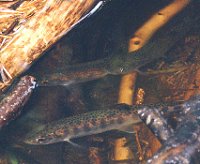 |
Species info |
 |
Life Cycle |
| |
 |
Glossary |
|
SALMON LIFE CYCLES
THE COHO SALMON
(Oncorhynchus kisutch)
When a salmon first hatches,
it is very small and is
called an alevin.
Alevin are born under the gravel in the bottom of a stream.
- Alevin:
- The first stage of a coho's life starts about 10 cm below the gravel of the smallest tributaries
of freshwater streams.
- Thousands of eggs per female are incubated over the winter season.
- Incubation rates are highly dependant on water temperatures (warmer = faster). An average
rate of incubation is 120 days in many areas of British Columbia.
- Coho are born with a large yolk sac attached to their belly which is usually depleted by the
time the alevin emerge from the gravel, about 3 weeks after hatching.
The salmon soon comes out of the gravel
and is then
called a Fry.

Fry:
- Come spring time, the fry are free swimming above the gravel.
- New fry measure about 30mm.
- They quickly seek shelter under banks and boulders in areas of low water velocity.
- Being very territorial, once a coho salmon establishes its territory (i.e. a boulder or log) it
will usually remain there, only venturing a meter or so out to catch food.
- After about six months in fresh water, fry will develop Parr
markings, and are commonly called parr.
- At one year of age (a yearling), the parr will measure about 110mm.
- High winter water flows will often force the young salmon into smaller tributaries and off channel habitat with slower waters to avoid being swept too far
downstream. Feeding and growth are minimal during the cold season.
- Come spring, most coho move back into the main stream.
Once the fry is old enough,
it swims downstream
towards the ocean.
It then smolts and enters the saltwater of the ocean.
Smolts:
- Smolts usually start migrating to sea during the spring of their second year in the stream, and
may continue until fall. They are usually no longer than 10-12cm. Migration usually occurs
during the night hours.
- When smolting, young salmon will lose their parr markings and develop a more silver
colour.
- An extra year may be spent in fresh water if condition are not favourable to healthy, fast
growth.
- Growth is very fast once saltwater is reached. However, added pressures from predators
decrease survival rates.
Ocean life can be very difficult for growing salmon.
They travel long distances and encounter many dangers.
In the Ocean:
- Schools of young coho salmon remain close to shore for several months.
- Generally smolts tend to migrate northwards along the coast and will reach coastal Alaska
by late summer.
- The southerly return migration occurs after about 12 months at sea.
- Many coho will swim a counter-clockwise circuit around the Gulf of Alaska.
- The route of migration is highly dependent on where the salmon find good feeding grounds.
- Coho prefer ocean temperatures greater than 6 degrees Celsius.
- Coho can achieve speeds as fast as 50 kilometers per day on long voyages.
- Coho are successful opportunistic feeders.
After a year in the ocean, the coho salmon returns to its
home stream.
Here it will swim to the area where it was born, and spawn.
It will soon die.
Spawning Salmon:
- Coho salmon begin maturing into adults during the summer, after one winter at sea.
- Salmon have a seemingly inherent ability to return to their original creeks, and even to the
same patches of gravel (redds) that they hatched in.
- It is unknown exactly how salmon navigate back to their birth creek from hundreds or
thousands of kilometers away, however, olfactory senses - their sense of smell - does guide them
as they approach familiar waters.
- A series of imprints on the young salmon occur when they are initially migrating to the
ocean. These imprints help guide them back to their native stream sections when they return to
spawn.
- Upon their return in the beginning of the winter season, coho salmon may have to wait in the
estuary to re-acclimatize to the fresh water conditions, and possibly to await access into their
streams. For example, heavy rains and tidal movement may be needed to raise water levels so
that the fish can swim across beaches into their creeks. Usually, water depths must be at least 18
cm and water velocities no more than 2.5 m/s (metres per second).
- Coho will spend most of their time in the deep pools while migrating. This allows them to
avoid the predatory dangers of the shallow, quick moving riffles.
- Their average size upon return is 4.0 kg, and a length of about 50 cm. Males are usually
larger than females.
- By turning on her side and flapping her tail up and down, the female uses the water to push
gravel around, and clears a depression in the gravel called a redd.
- Once the redd is deep enough, the female prepares to lay her eggs. The dominant male, who
until now defended her, gets very close to her and releases sperm into the gravel nest. Other
males may also deposit sperm into the nest.
- Once the act is finished, the female will immediately cover up the fertilized eggs to
minimize predation. As the same time, she is creating a new depression for the next nest.
Usually, 3 to 5 nests will be spawned in, and 800 to 1000 eggs will be laid, per female.
- The spawned-out salmon will live only for another 3-15 days. During this time they will
defend their nests until they no longer have enough energy.
- Frayed fins, fungus, and infections are common deteriorations which occur before the
salmon dies and floats downstream.
Top of page.
|

